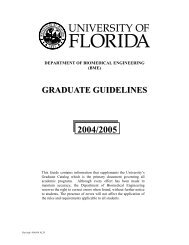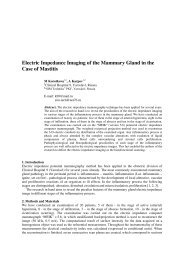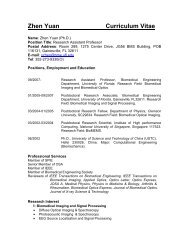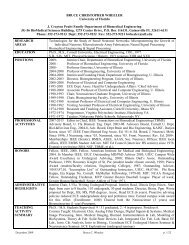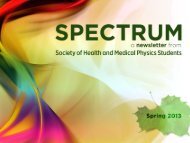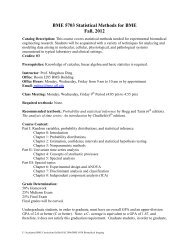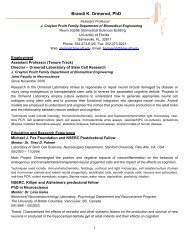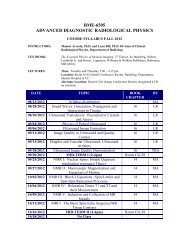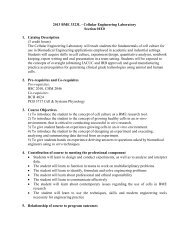Smirnov, A V; Nikolaev, D V; Kolesnikov, V A
Smirnov, A V; Nikolaev, D V; Kolesnikov, V A
Smirnov, A V; Nikolaev, D V; Kolesnikov, V A
Create successful ePaper yourself
Turn your PDF publications into a flip-book with our unique Google optimized e-Paper software.
Figure 1. Equivalent scheme of themeasurement circuitBIA measurement errors were analyzed boththeoretically, i.e. using equivalent scheme calculations,and experimentally, i.e. by measuring the impedancesof reference circuits. Two kinds of errors wereconsidered: calibration errors as well as extra errorsdue to differences between the parameters ofequivalent scheme during measurement compared tothose during calibration procedure. Much attention waspaid to extra errors as calibration errors are systematicin nature and, hence, their influence can be minimized.Equivalent measurement circuit is shown on Fig. 1,where 1–4 – electrodes’ clamps, CG – currentgenerator, Z B – biological object impedance, C s – straycapacity, VM – voltmeter, Z C1 , Z C2 , Z C3 , Z C4 – contactimpedances, C 12 , C 13 , C 24 , C 34 – interelectrodeconsists of electrode’s own impedance, impedance ofcapacities. Each of impedances Z C1 –Z C4electrode to body contact, and impedance of body part between current and voltage electrodes.Capacities C 12 –C 34 are influenced by the device and cables capacities. It can be shown that theinfluence of the capacitance C s is equivalent to that of distributed stray capacitance between thesubject and surrounding objects.We simulated calibration and measurement procedures. For this, U m values were calculated usingequivalent circuit by the node potentials method. We utilized the same values of C 12 –C 34 on calibrationand measurements because of using the same cable. For contact impedances Z C1 –Z C4 , similarassumption is not reasonable because of dependence on the types of electrodes, their positioning, andthe properties of skin. The measurements using analyzer ABC-01 “Medass” includes registration ofthe impedances Z 13 and Z 24 between 1-3 and 2-4 clamps. These impedances give an approximation ofZ C1 and Z C2 impedances used in calculation of measured impedance. Such a correction was alsoimplemented during simulation of measurements. The data on interelectrode capacities and contactimpedances Z C3 and Z C4 were obtained from auxiliary experiments.Verification of the measurement model present in Fig. 1 was carried out by the comparison ofcalculated and experimentally derived error values. Then, using the obtained error values, possibledeviations of impedance spectrum under corresponding measurement conditions were analyzed.3. ResultsThe results of segmental BIA measurements of the impedance spectrum for healthy volunteer arepresented in Fig. 2. Similar spectrums were obtained for other volunteers. Fig. 3 shows estimates ofcontact impedances for electrode types E1 and E2.Fig. 4 shows the results of theoretical and experimental analysis of extra errors. Calculations ofexpected values of measurement errors of the resistance R and reactance X were performed for afrequency of 500 kHz in the range of R between 50 and 400 Ohms at X/R = 0,1. The following realvalues of interelectrode capacities were used: C 12 = 40 pF, C 34 = 60 pF, C 13 = C 24 = 70 pF. The valuesof impedances that simulated contacts at calibration were Z C1 = Z C2 = 100 Ohms, Z C3 = Z C4 == 10 Ohms. The values of contact impedances during measurement (based on Fig. 3b) were Z C1 = Z C2= 170 Ohms, Z C3 = Z C4 = 120 Ohms for E1 electrode type, and Z C1 = Z C2 = 70 Ohms, Z C3 = Z C4 = 40Ohms for E2 electrode type. Calculations with other parameters show that, in first approximation, themagnitude of errors is proportional to the frequency value and interelectrode capacities. Experimentalestimates of measurement errors, denoted as E1exp and E2exp, were obtained using reference circuitsthat simulated biological object and contacts of E1 and E2 electrodes. Calibration errors wereexcluded by measurement of reference circuits corresponding to calibration conditions.Results of approximation of the impedances of measured body segments using the impedance Z Coleand capacitance C p taken in parallel are given in Table 1.



